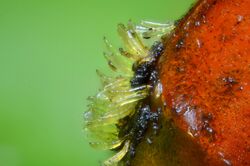Biology:Hesperomyces
| Hesperomyces | |
|---|---|

| |
| Laboulbeniales on a ladybird, Hesperomyces harmoniae | |
| Scientific classification | |
| Domain: | Eukaryota |
| Kingdom: | Fungi |
| Division: | Ascomycota |
| Class: | Laboulbeniomycetes |
| Order: | Laboulbeniales |
| Family: | Laboulbeniaceae |
| Genus: | Hesperomyces Thaxt. (1891) |
| Type species | |
| Hesperomyces virescens Thaxt. (1891)
| |
| Species | |
|
See text | |
Hesperomyces is a genus of fungi in the family Laboulbeniaceae. The genus contains ten species,[1] including the type species, the Green Beetle Hanger (Hesperomyces virescens).[2] H. virescens is a complex of species.[3] It is an ectoparasite of an invasive species to Europe and the Americas,[4] the harlequin ladybird (Harmonia axyridis).[5] Laboratory bioassays pointed out that Hesperomyces-infected ladybirds suffered increased mortality rates.[6]
The fungus completes its entire life cycle on the tough outer layer or integument of a living host where individual fruiting bodies or thalli are formed directly from ascospores. The thalli can form on any part of the insect, but spore germination likely only occurs once the host cuticle has hardened. The spores are believed to have a short life span. Due to the spores' sticky nature, they are not transmitted by contact with substrate or the air. Instead they are spread directly by host activities and it is suggested that transmission occurs during feeding and mating season when sexual contact occurs, therefore making H. virescens a sexually transmitted disease of insects.[7]
Species
- Hesperomyces auriculatus W.Rossi & M.Leonardi (2018)
- Hesperomyces biphylli K.Sugiy. & T.Majewski (1985)
- Hesperomyces catopii Thaxt. (1931)
- Hesperomyces chilomenis (Thaxt.) Thaxt. (1931)
- Hesperomyces coccinelloides (Thaxt.) Thaxt. (1931)
- Hesperomyces coleomegillae W.Rossi & A.Weir (2014)
- Hesperomyces harmoniae Haelew. (2022)
- Hesperomyces hyperaspidis Thaxt. (1931)
- Hesperomyces palustris W.Rossi & A.Weir (2014)
- Hesperomyces papuanus T.Majewski & K.Sugiy. (1985)
- Hesperomyces virescens Thaxt. (1891)
References
- ↑ Das, Kanad; Rossi, Walter; Leonardi, Marco; Ghosh, Aniket; Bera, Ishika; Hembrom, Manoj E; Bajpai, Rajesh; Joseph, Siljo et al. (2018). "Fungal Biodiversity Profiles 61 - 70". Cryptogamie, Mycologie 39 (4): 381–418. doi:10.7872/crym/v39.iss4.2018.381. ISSN 0181-1584. https://bioone.org/journals/cryptogamie-mycologie/volume-39/issue-4/v39.iss4.2018.381/Fungal-Biodiversity-Profiles-61---70/10.7872/crym/v39.iss4.2018.381.full.
- ↑ "Ladybug Fungi :Cornell Mushroom Blog". https://blog.mycology.cornell.edu/2014/01/17/ladybug-fungi/.
- ↑ Haelewaters, Danny; De Kesel, André; Pfister, Donald H. (2018). "Integrative taxonomy reveals hidden species within a common fungal parasite of ladybirds" (in en). Scientific Reports 8 (1): 15966. doi:10.1038/s41598-018-34319-5. ISSN 2045-2322. PMID 30374135.
- ↑ Werenkraut, Victoria; Baudino, Florencia; Roy, Helen E. (July 7, 2020). "Citizen science reveals the distribution of the invasive harlequin ladybird (Harmonia axyridis Pallas) in Argentina". Biological Invasions 22 (10): 2915–2921. doi:10.1007/s10530-020-02312-7. https://link.springer.com/article/10.1007%2Fs10530-020-02312-7. Retrieved 19 August 2021.
- ↑ Roy, Helen E.; Brown, Peter M. J.; Adriaens, Tim; Berkvens, Nick; Borges, Isabel; Clusella-Trullas, Susana; Comont, Richard F.; De Clercq, Patrick et al. (2016). "The harlequin ladybird, Harmonia axyridis: global perspectives on invasion history and ecology" (in en). Biological Invasions 18 (4): 997–1044. doi:10.1007/s10530-016-1077-6. ISSN 1387-3547. http://link.springer.com/10.1007/s10530-016-1077-6.
- ↑ Haelewaters, Danny; Hiller, Thomas; Kemp, Emily A.; van Wielink, Paul S.; Shapiro-Ilan, David I.; Aime, M. Catherine; Nedvěd, Oldřich; Pfister, Donald H. et al. (2020). "Mortality of native and invasive ladybirds co-infected by ectoparasitic and entomopathogenic fungi" (in en). PeerJ 8: e10110. doi:10.7717/peerj.10110. ISSN 2167-8359. PMID 33194385.
- ↑ Haelewaters, Danny; Minnaar, Ingrid A.; Clusella-Trullas, Susana (2016). "First finding of the parasitic fungus Hesperomyces virescens (Laboulbeniales) on native and invasive ladybirds (Coleoptera, Coccinellidae) in South Africa". Parasite 23: 5. doi:10.1051/parasite/2016005. ISSN 1252-607X. PMID 26861616.
 Text was copied from this source, which is available under a Creative Commons Attribution 4.0 International License.
Text was copied from this source, which is available under a Creative Commons Attribution 4.0 International License.
Wikidata ☰ Q5746029 entry
 |

